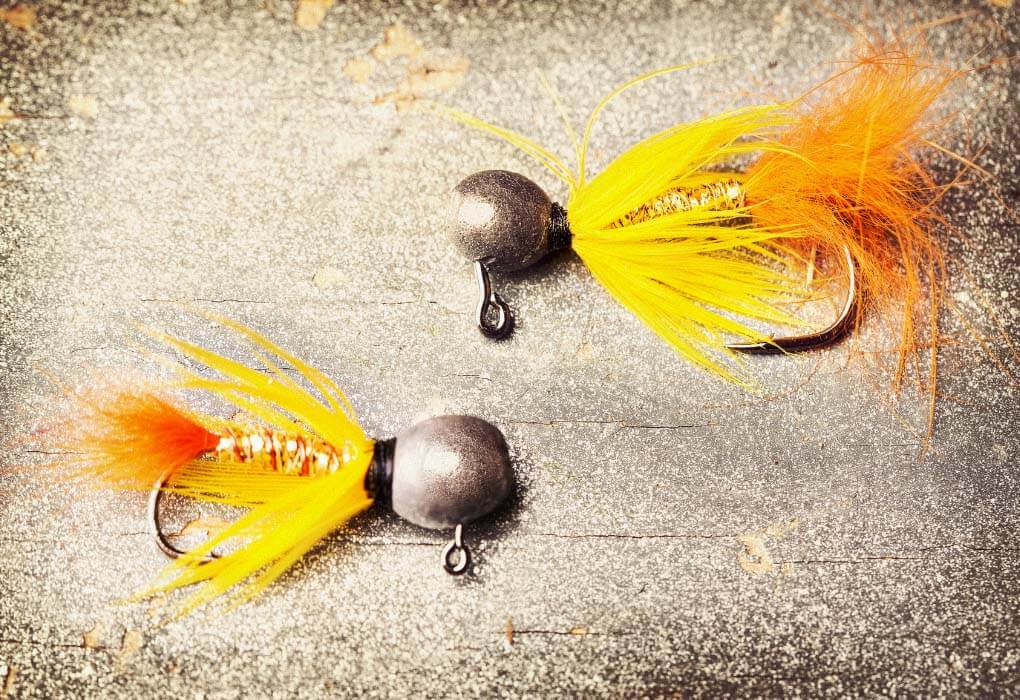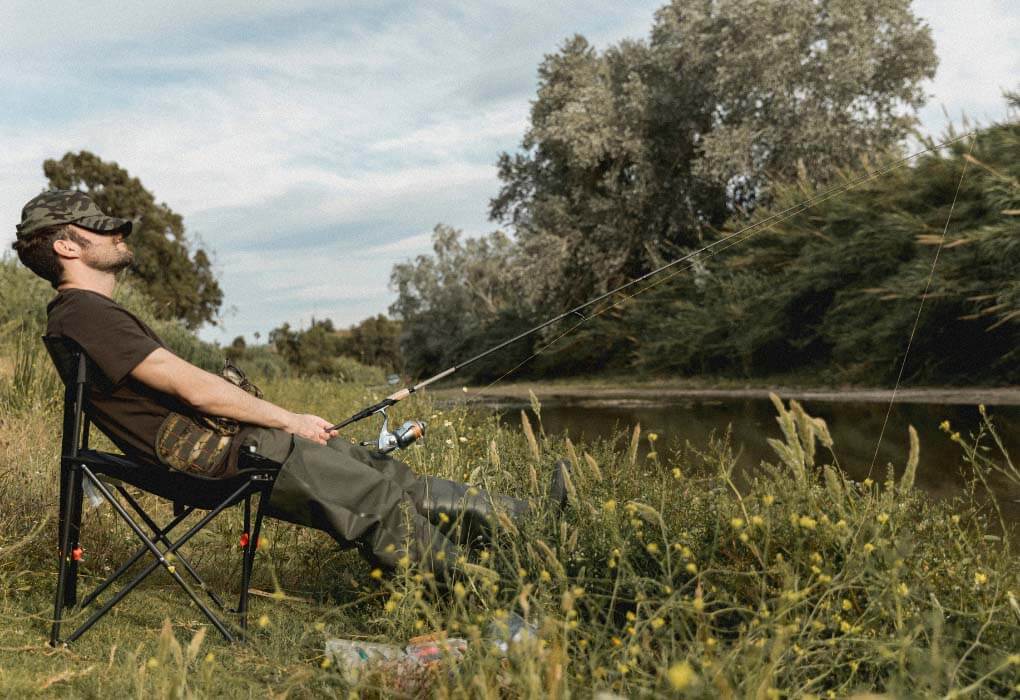Growing up, I didn’t have a lot of smallmouth bass fishing opportunities. So when I first hooked into a good smallmouth, I was hooked (well, technically, the fish was hooked).
I’ve traveled north near the Great Lakes for several years to fish for smallmouth. The following tips are what I’ve picked up and learned the hard way during these trips.
How to Catch Smallmouth Bass in Lakes

Catching smallmouth bass in lakes requires a different approach than catching largemouth bass. The first time I went fishing for smallmouth, I was stuck in a largemouth bass fishing mindset.
However, it didn’t take long for me to change gears and use smallmouth bass fishing techniques and start catching a few.
Tip #1 Make Long Casts
Smallmouth are typically found in clear water, which is nice because you can see the fish. However, that also means the fish can see you and spook easily.
Making a long cast helps keep the odds in favor of the fish seeing your lure before it sees you.
This is most easily accomplished by learning how to cast a baitcasting rod and reel. Bass anglers prefer a baitcaster because of the increased casting distance and accuracy compared to a spinning rod and reel.
Tip #2 Downsize Your Lure BUT Not Too Much

I’ve caught loads of small bass on lures nearly as big as they were, but when you downsize your lure for smallmouth, it increases the chance of getting a hook into their mouth.
So if you’re looking to catch your first smallmouth, I suggest using smaller lures than you typically would; even big smallies will hit a small lure.
However, if you’re targeting that trophy bronzeback, don’t downsize too much because you’ll have to weed through a lot of tiny smallmouth bass when using a smaller lure.
My favorite smallmouth bass rigs to throw are soft plastic worms, wacky rigged on a drop shot, finesse jigs, chatterbaits, and Mepps spinners or small spinnerbaits.
Tip #3 Downsize Your Fishing Line
Using a smaller diameter line makes it even harder for the fish to see in the water. It also allows the lure to act as naturally as possible, which is critical for clear water fishing.
I prefer an 8-10-pound test line when fishing moving baits, and when fishing a finesse presentation, I’ll opt for a 6-pound line on my smallmouth bass setup.
Downsizing your line means you must properly set your drag; otherwise, you will break off when you set the hook on a big bronzeback.
It’s best to have a little resistance before your drag kicks in; that way, you can get a solid hook set.
Tip #4 Fish Depth Changes
Most of the smallies I’ve caught have been around a quick depth change.
This is because they can easily escape to deeper water when predators are above, and they can feed on the small fish that inhabit the shallows.
Depth change is a relative term, but I typically look for a quick change of at least 1ft. A slow, gradual slope is not what I’m talking about.
Tip #5 Fish Around Structure
In the lake, I smallmouth fish the most; there are rockpiles leftover from a glacier where the bass most often congregate.
Fish use structures like these rock piles throughout the year as staging areas. I think of a staging area as a place where the fish is most comfortable because it has nearly everything it needs.
They use these areas pre and post-spawn, which means they’re high percentage locations.
If you’re fishing in a reservoir (man-made lake), it’s unlikely you have glacial rock piles; but you can still find structures that smallies relate to, like creek channels, drop-offs, rip-rap, and brush piles.
In a Major League Fishing article, Jonathan VanDam reminds us that you’ll stumble across smallmouth bass when fishing for largemouth along a ledge, even in the south.
How to Catch Smallmouth Bass in Rivers

A river is probably my favorite type of fishery. Whether you’re fishing a big river like the mighty Mississippi River or a small clear water stream, you can use a few smallmouth bass fishing tips to increase your chances of success.
Tip #1 Take Advantage of Current Breaks
Brown bass will hang out behind a rock or tree in the water, waiting on their next meal.
The rock forces the water around it, creating a break in the current, which allows the bass to work much less while searching for its next meal.
Eddies along the shoreline are another spot where bass will spend most of their time waiting for the next minnow to get pushed downstream.
Predatory fish like black bass spend a lot of time downstream of ripples, rapids, and falls because they don’t have to work hard to have food brought to them.
Tip #2 Use Natural Fishing Lures
Smallmouth are opportunistic feeders, which means they’re not picky. However, you are always better off using something that looks exactly like what they’re eating.
This means using crankbaits that look like crawfish, jerkbaits that look like injured minnows, or topwater poppers imitating hurt shad or sunfish.
Though I haven’t tested it myself, catching a smallie while fly fishing looks intense. So don’t be afraid to use lures that look like insects and insect larva.
Tip #3 Use Live Bait

Most bass anglers frown on live bait. However, I highly recommend using live bait to catch bass if you’re fun fishing.
It’s the best bait because you’re using what the bass already eat on a daily basis.
What do smallmouth bass eat? Earthworms, minnows, crayfish, grubs, helgramites, and grasshoppers make excellent smallmouth baits.
Tip #4 Set Your Drag
Fighting a fish in a river is a little more challenging than fighting one in a lake because of the current.
The current can make a small fish feel much bigger; it can also cause you to break off easier.
This is why setting your drag before you cast is crucially important.
You want to fight a fish without worrying about breaking your line, but you also need to be able to keep the fish out of unwanted areas like a laydown.
Tip #5 Keep Safety in Mind
Many people underestimate how powerful water is; even a slow-moving river can be dangerous.
That’s why it’s essential to choose your safety over fish. No matter how juicy a spot looks, it’s not worth risking your life to fish.
When I’m kayak fishing on a river, I always have my life jacket on, and I rarely fish in a river alone.
Smallie Facts That Will Help You Land a Giant

As far as freshwater fishing goes, smallmouth bass are one of the hardest fighting fish pound for pound. This is why they’re a highly sought-after game fish.
I consider a 5 lb smallmouth bass or bigger to be a giant because they often feel as though you’re reeling in a 10 lb largemouth.
With that in mind, here are a few facts regarding how to fish for smallmouth bass.
They’re Aggressive, But Smart
I have had big smallies follow my lure back to the boat without biting it because they could tell something was off, even though they wanted to eat it.
Biggun’s Hangout Together
Whenever I find a school of smallmouths, they’re usually about the same size. So if you’re only catching little ones, it’s time to change locations.
They’ll Eat Big Baits
If a black bass thinks it can eat it, it will try, even if it’s the same size as the bass. Switching to a larger bait will help weed out the small ones so you can target the big smallmouth bass.
Frequently Asked Questions
What is the best bait for smallmouth bass?
The best bait for smallmouth bass is a small plastic worm on a drop shot. I’ve caught a lot of smallies on this setup, which is why I think it’s the best way to catch smallmouth bass.
What is the best time to catch smallmouth bass?
The best time to catch smallmouth bass is during the spawn. They’re naturally more aggressive than largemouth, but their aggression increases when guarding their nest.
How do you find smallmouth bass?
To find smallmouth bass, you need to look in the smallmouth bass habitat they frequent the most during that time of year.
Smallmouth bass patterns in the spring will be shallow when spawning. During the summer, smallies will school in deep water.
Then in the fall, they move back shallow to feed heavily before winter.
How big do smallmouth bass get?
Smallmouth bass can get as big as 12lbs. The world record is currently 11lbs 15oz, but most smallmouth bass are 1-4lbs.
Last Cast
Smallmouth bass fishing is an art we try to master, but when we think we’ve got it figured out, they change and leave us confused.
However, if you follow the tips listed above, you’ll be able to adapt to the changing conditions and catch the biggest smallmouth of your life.
I’d love to read your smallmouth fishing tips in the comment section!




